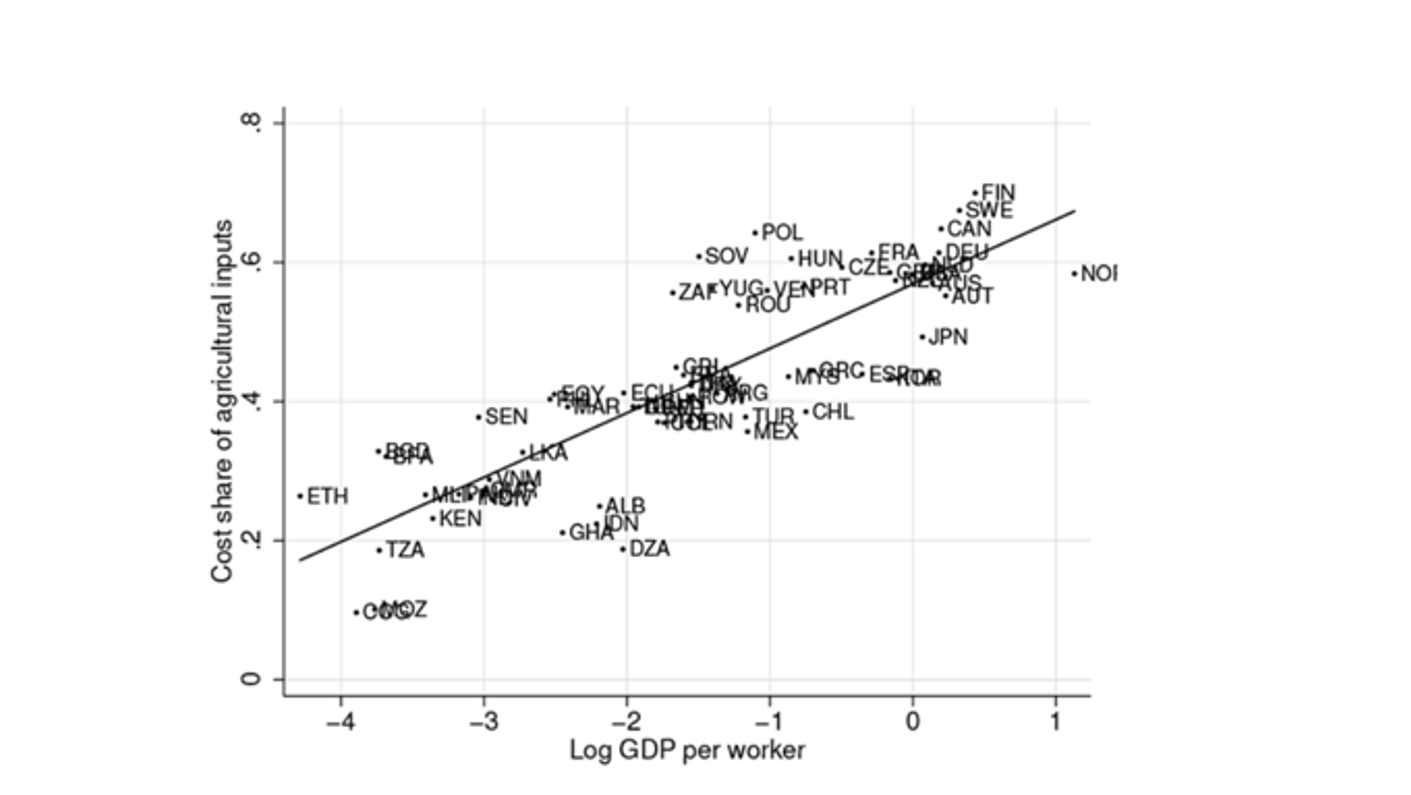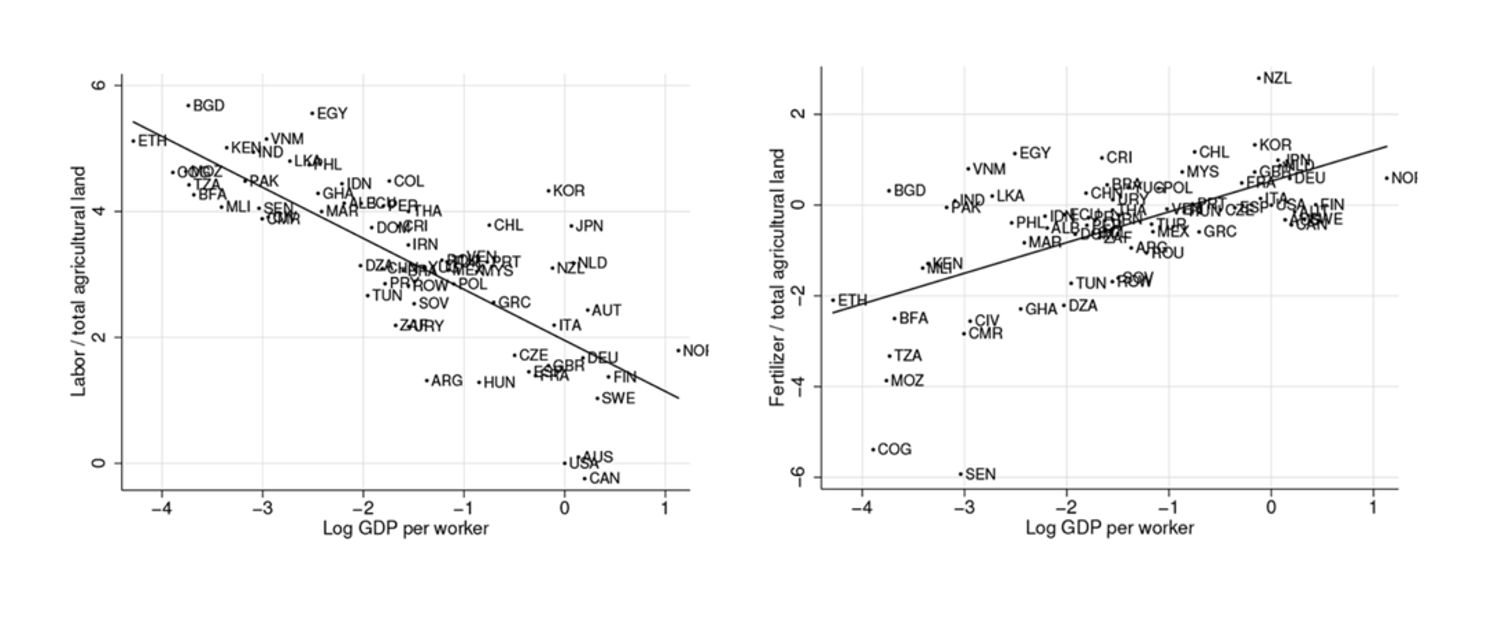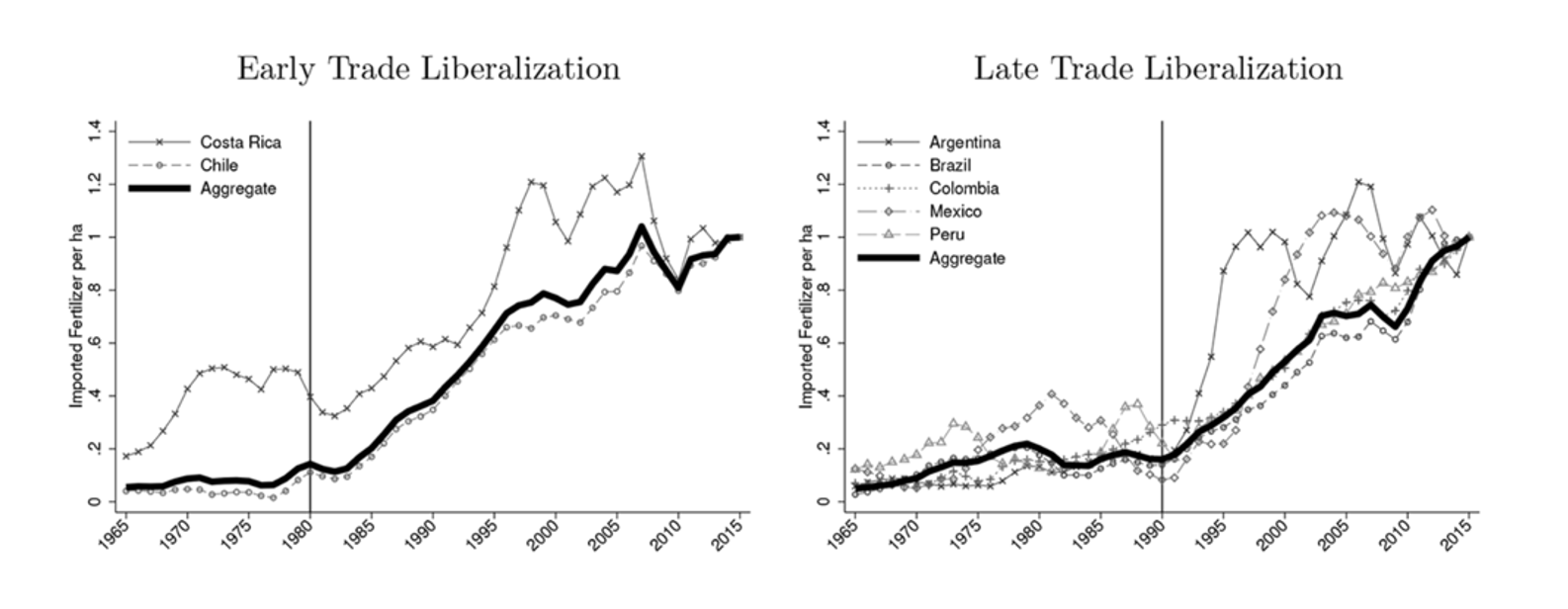
By facilitating access to critical agricultural inputs such as chemical fertilisers and farm machinery, trade has spurred agricultural modernisation that has raised agricultural yields and increased food consumption worldwide.
The gains from agricultural trade have long been viewed through the lens of international specialisation in agricultural outputs, such as soybean, corn, and coffee. When trade barriers fall, countries can specialise in crops best suited to their resources and climate, while relying on imports to meet their demand for other crops. The resulting pattern of specialisation, driven by comparative advantage in crops, leads to a more efficient global agricultural production, as reviewed in Eaton and Kortum (2012) and Donaldson (2019).
This traditional view, however, overlooks a crucial aspect of how trade has transformed agriculture. Nowadays, two-thirds of a dollar spent on agricultural inputs, such as chemical fertilisers and farm machinery, is paid to foreign suppliers through imports. Our research shows that trade in agricultural inputs has been as important as trade in agricultural outputs in driving the gains from agricultural trade in recent decades (Farrokhi and Pellegrina 2023). By facilitating access to these critical inputs, trade has spurred adoption of modern, input-intensive agricultural technologies. This process, which is typically referred to as agricultural modernisation, has significantly improved agricultural yields, increased food consumption, and released labour from agriculture worldwide.
The importance of trade in agricultural inputs: A look at the data
While traditional farming is intensive in the use of labour and land, modern agricultural technologies are intensive in the use of agricultural inputs such as modern seeds, fertilisers, pesticides, tractors and combines.
When we look across countries, a defining feature of economic development is that the cost share of agricultural inputs relative to labour and land increases with GDP per capita (Donovan 2021). This pattern is illustrated in Figures 1 and 2. Figure 1 shows that the cost share of agricultural inputs rises from 25% in the lowest income per capita quartile of countries to 60% in the highest one. Figure 2A and 2B show that higher-income per capita countries employ less labour per unit of land while using fertilisers more intensively per unit of land.
Figure 1

Figure 2a and 2b

This agricultural intensification is driven by the adoption of modern agricultural technologies, which deliver substantially higher yields compared to traditional farming. The global average yield premium of modern technologies over traditional ones ranges from four to seven across various crops. These figures are taken from detailed data provided by the Food and Agricultural Organization’s Global Agroecological-Zone (FAO-GAEZ) project on measures of agricultural productivities, by crop and technology type. They highlight the enormous potential for productivity gains through the adoption of modern technologies.
If countries could rely entirely on domestic sources to adopt modern agricultural technologies, international trade would be unnecessary. But the data tells us a very different story.
Globally, two-thirds of a dollar spent on agricultural inputs goes to foreign suppliers through imports. This means that farmers in many countries rely heavily on international trade to access one or more types of agricultural inputs. These inputs, in turn, are critical for adopting and utilising modern agricultural technologies.
The heavy reliance on imports reflects the high geographic concentration in the production of agricultural inputs. Around 80% of global exports of agricultural inputs come from just 10 countries. Fertiliser production, for example, is limited to regions with abundant natural resources such as phosphate or potash deposits, while the manufacturing of pesticides and many varieties of farm machinery depends on industrial centres that are often non-existent in developing countries.
Agricultural input use in Latin America during episodes of trade liberalisation
To set the stage for our analysis that follows, let us provide anecdotal evidence on agricultural input intensification during episodes of trade liberalisation in Latin America. Figure 3 highlights fertiliser imports per hectare in select Latin American countries, which experienced substantial trade liberalisation—Chile and Costa Rica in the 1980s, and others in the 1990s. In all cases, fertiliser imports per hectare increased sharply during or shortly after these liberalisation periods. As trade liberalisation progressed in Latin America, the imported share of expenditure on fertilisers rose, on average, from 40% in 1980 to 90% in 2010.
Figure 3

A framework incorporating farmers’ choices of both crops and technologies
We develop a global trade model in which farmers choose not only which crops to grow but also which technologies to use in growing them. Relative to previous research, we introduce the production and trade of agricultural inputs, used in modern technologies, and analyse how farmers’ access to these inputs via international trade influences their choices of agricultural technologies. Specifically, we allow for two types of technologies: traditional technologies that are intensive in the use of labour and do not use intermediate agricultural inputs; and modern technologies that are labour-saving and intensively use agricultural inputs.
The gains from trade cost reductions in agricultural inputs come from mechanisms that are distinct from those of agricultural outputs. When trade barriers for agricultural outputs fall, countries specialise in crops where they have a comparative advantage—a well-examined effect in previous studies, e.g. Costinot et al. (2016) and Sotelo (2020). In contrast, when trade barriers in the agricultural input sector fall, the relative price of agricultural inputs compared to local wages of labour decreases. This incentivises farmers to move away from traditional, labour-intensive technologies and to adopt modern, input-intensive technologies.
By bringing agricultural technology choices to trade models, our work complements classic studies of agricultural modernisation, which have studied this process in closed economies, e.g. Gollin et al. (2007). Our analysis underscores the importance of trade in agricultural inputs to the rise of agricultural modernisation in recent decades.
We take our model to the detailed grid-level data from the FAO-GAEZ project on crop and technology-specific agricultural productivities, which include a million grid cells covering the Earth’s surface. Moreover, we use trade and production data on agricultural outputs and inputs to fully estimate our model.
Measuring the impact of globalisation and foreign productivity growth in the agricultural input sector
With our estimated model, we conduct two sets of policy analyses regarding the role of trade in agricultural modernisation.
In our first set of policy analyses, we explore the impact of decades of falling trade barriers, which we refer to as “globalisation”, on technology adoption, agricultural productivity, and welfare. Our policy analysis uncovers the relative role of globalisation in agricultural inputs, driven by technology adoption, compared to its role in agricultural outputs, shaped by international crop specialisation.
Our findings indicate that, in recent decades, trade in agricultural inputs has been just as important as trade in agricultural outputs for global welfare. In other words, ignoring the input-side mechanisms that have driven agricultural modernisation would overlook half of the welfare gains from globalisation within the agricultural sector.
We also highlight that the distributional impacts of these two mechanisms are substantially different. Trade in agricultural outputs benefits low-income countries the most, as low-income countries allocate a higher share of their expenditure to food. In contrast, trade in agricultural inputs has widened the gap between low- and middle-income countries while compressing the gap between middle- and high-income countries.
Two key factors explain why low-income countries have lagged behind in reaping the benefits of trade in agricultural inputs. First, much of the land in these regions is under traditional, labour-intensive farming, which limits the potential gains from modern agricultural inputs. Second, domestic frictions such as large internal trade costs have slowed the adoption of modern technologies in low-income countries.
In our second set of policy analyses, we explore the gains from foreign productivity growth in the agricultural input sector—gains made possible through international trade, beyond the impact of domestic productivity growth. Our findings show that the contribution of productivity growth in foreign agricultural input sectors to welfare has been on average equivalent to half of the contribution of a countries’ own productivity growth in these sectors. Moreover, foreign productivity growth has acted as an international push force, driving structural change around the world by promoting the adoption of labour-saving agricultural technologies.
References
Costinot A, D Donaldson, and C Smith (2016), "Evolving comparative advantage and the impact of climate change in agricultural markets: Evidence from 1.7 million fields around the world," Journal of Political Economy 124(1): 205–248.
Donaldson D (2019), "Comparative advantage and agricultural trade," Agricultural Economics 50: 29–40.
Donovan K (2021), "The equilibrium impact of agricultural risk on intermediate inputs and aggregate productivity," The Review of Economic Studies 88(5): 2275–2307.
Eaton J, and S Kortum (2012), "Putting Ricardo to work," Journal of Economic Perspectives 26(2): 65–90.
Farrokhi F, and H S Pellegrina (2023), "Trade, technology, and agricultural productivity," Journal of Political Economy 131(9): 2509–2555.
Gollin D, S L Parente, and R Rogerson (2007), "The food problem and the evolution of international income levels," Journal of Monetary Economics 54(4): 1230–1255.
Sotelo S (2020), "Domestic trade frictions and agriculture," Journal of Political Economy 128(7): 2690–2738.


